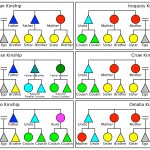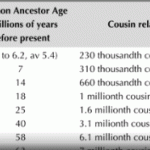genealogy
Inspired by Karin Bojs's and Peter Sjölund's recent book Svenskarna och deras fäder, I've looked into my ancestry by means both genetic and genealogical. Here's a few highlights.
Like most Stockholmers, I'm of mixed rural Swedish stock. My great grandpa's generation contains 16 people born mainly in the 1880s. Only one of them was born in Stockholm. His parents were born in Värmland and Södermanland provinces. The other 15 were born all over rural southern Sweden: Bohuslän (two people), Småland (two people), Södermanland, Skåne and Närke. They went to Stockholm to find work, met and got…
My personal genealogy has never interested me much, knowing as I do that the number of ancestors multiplies by a factor of two with each generation. Thus in AD 1800 someone born in 1975 had about 2^8=256 ancestors of child-bearing age (or slightly fewer if someone has been productive in more than one slot on the diagram). Finding out that a historical figure contributed 1/256 to my genetics and social heritage would not make them all that much more interesting to me.
I draw the line at three generations back, with people that are still remembered. In my case they illustrate an interesting and…
I gave a talk at the Brookdale Public Library last night as part of the celebration of DNA day. DNA Day, or DNAD for short, was created about the time of the "completion" (more or less) of the Human Genome in 2003, and is set to be on the date of the publication of the famous research on the structure of DNA.
The point of the talk was to link behavioral biology and the anthropological study of kinship with the practice of conducting personal genealogy. There was a time when I did a fair amount of genealogical research, in connection with historic archaeology, which in turn was part of…
Over at Evolutionary Genealogy, Leonard Eisenberg has been thinking about how we're related to other animals. Not so much in the evolutionary sense, but in the familial sense. After all, if your cousin is simply the offspring of your parent's sibling, why not continue that logic back a few hundred millennia or so?
To make a rough estimate of the cousin and removal relationship between you and any other living thing, all one needs to do is count up the generations back to the common ancestor. This sounds easy in theory but is complicated in practice. First, make an estimate of the number of…
Maybe you did it for the extra cash. Maybe you wanted to be part of the sperm cube public art project. Whatever the reason, it's possible, just possible, your sperm took on a life of it's own, once you left it.
And now that a genome is no longer an entirely personal bit of information, you may be in for a surprise meeting someday, with the end result.
That's right.
Male adoptees are getting their DNA tested and getting information about their possible surnames.
According to the BBC news:
At least 30 men registered with US consumer genetic testing firm Family Tree DNA have found their…
You can find out. Blaine Bettinger, the Genetic Genealogist has a fun little quiz.
Students at Soldan International High School are participating in an amazing experiment and breaking ground that most science teachers fear to tread.
Soldan students, along with hundreds of thousands of other people, are participating in the National Geographic's Genographic Project. Through this project, students send in cheek swabs, DNA is isolated from the cheek cells, and genetic markers are used to look at ancestry.
Genetic markers in the mitochondrial DNA are used to trace ancestry through the maternal line and markers on the Y chromosome can be used to learn about one's father.…

